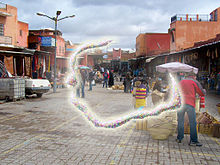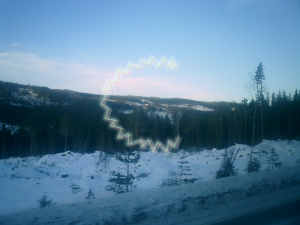Scintillating scotoma, also called flickering scotoma or visual migraine, is the most common visual aura preceding migraine. Many variations occur, but scintillating scotoma usually begins as a spot of flickering light near or in the center of the visual field, which prevents vision within the scotoma area. The affected area flickers but is not dark. It then gradually expands outward from the initial spot. Symptoms typically appear gradually over 5 to 20 minutes and generally last fewer than 60 minutes, leading to the headache in classic migraine with aura, or resolving without consequence in acephalgic migraine
闪辉性暗点是一种常见的视觉异常。其表现形式多样,最常见的是从视野中央或者旁中央出现闪烁状的光斑,并渐渐扩大。闪烁区域看不清楚东西。通常持续5到20分钟,也可能长达1小时。之后伴有偏头痛,但也可能没有头痛。



Causes
Scintillating scotomas are most commonly caused by cortical spreading depression. The assumed mechanism should lower the cortical threshold for spontaneous excitation.
病因
闪辉性暗点常见于大脑皮层扩散性抑制,其机制是区域性神经元或神经胶质细胞强烈去极化并以3~5 mm/min的速度沿皮层向邻近区域传播(spreading),从而导致神经活动抑制(depression)。
Prognosis
The Framingham Heart Study (published in 1998) found that scintillating scotomas without other symptoms occurred in 1.23% of the group. The study did not find a link between late-life onset scintillating scotoma and stroke.
预后:
该病在中年人的发病率约是1.23%。研究没有发现闪辉性暗点与脑卒中(中风)有关联。